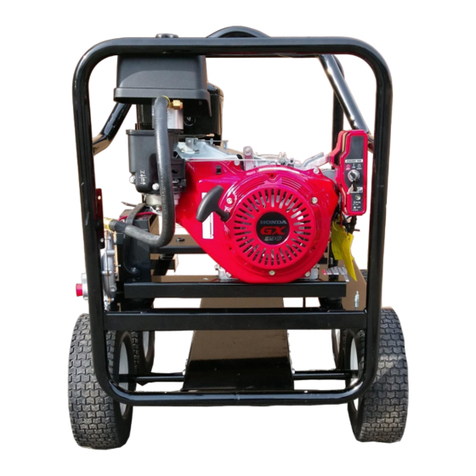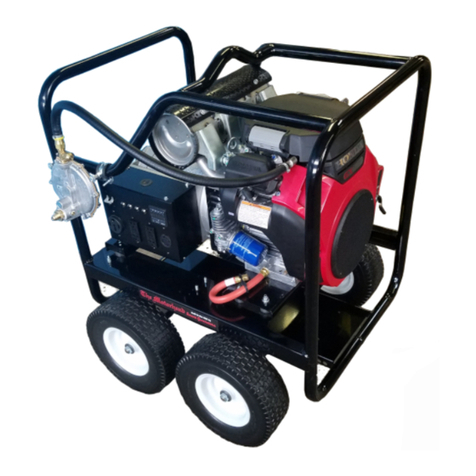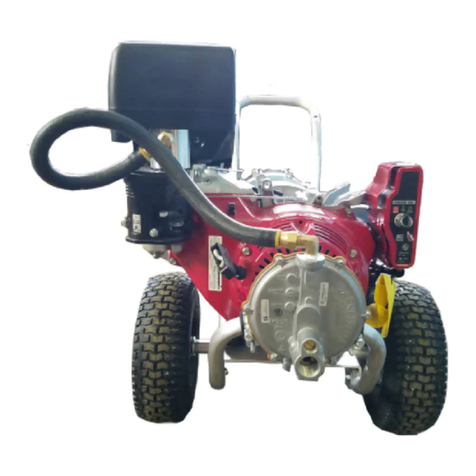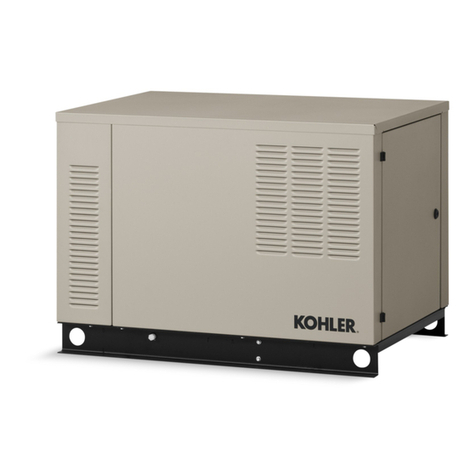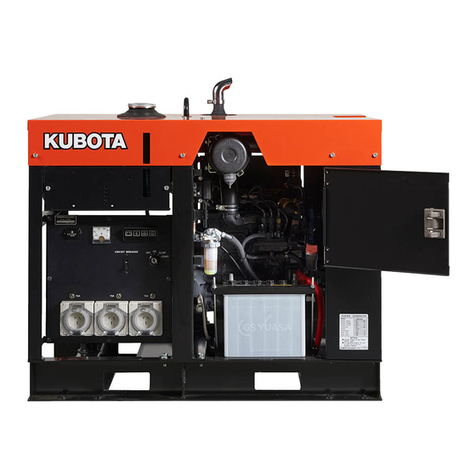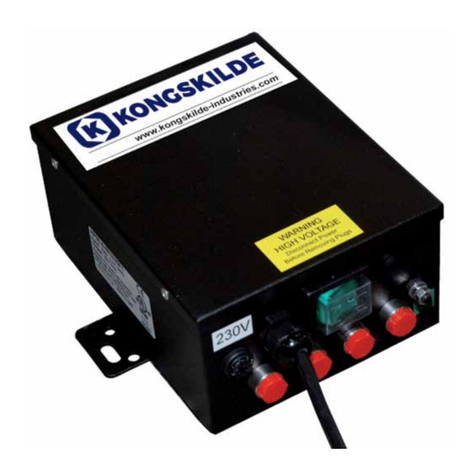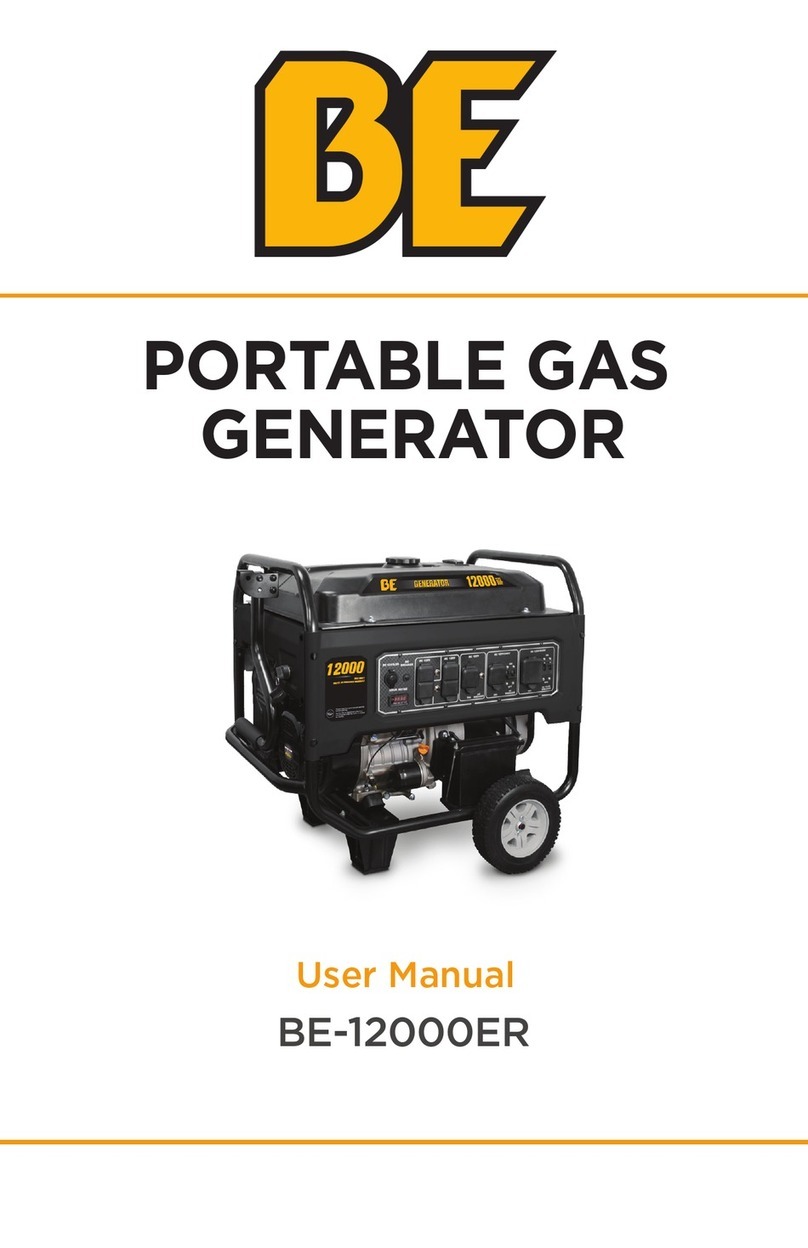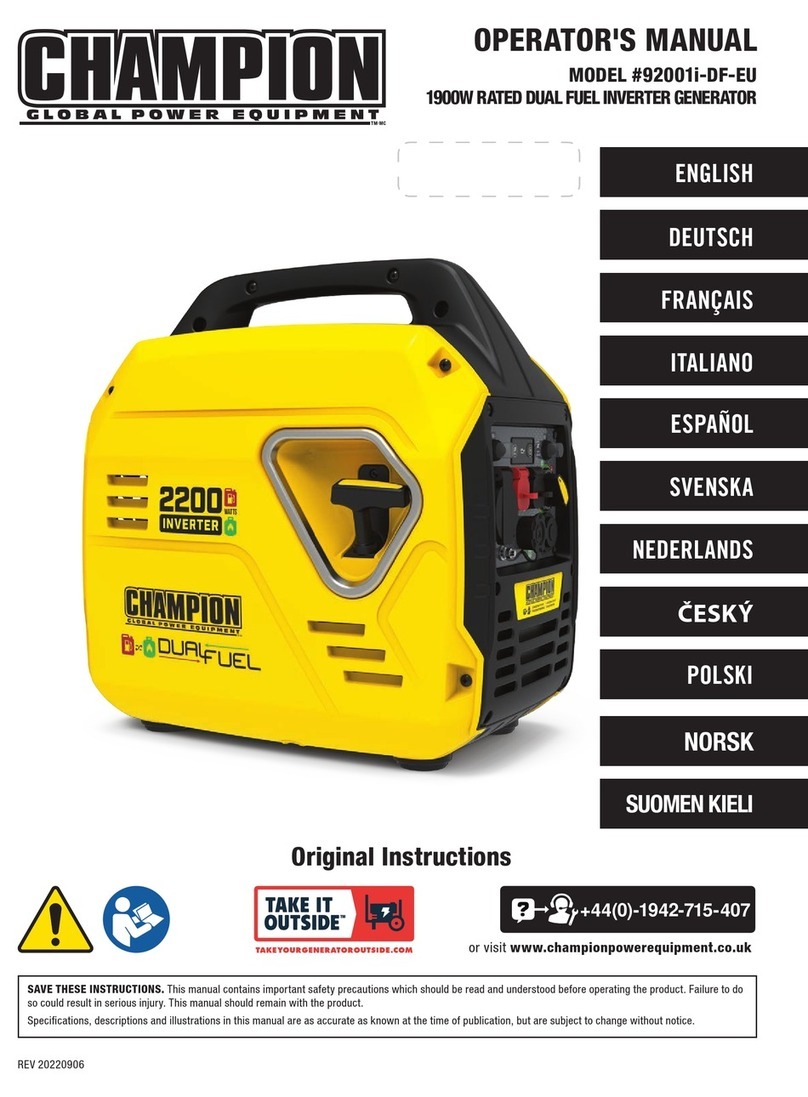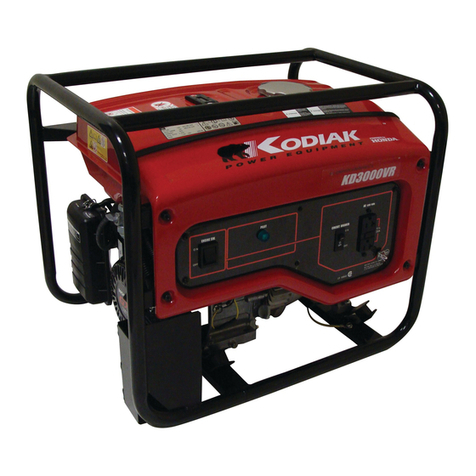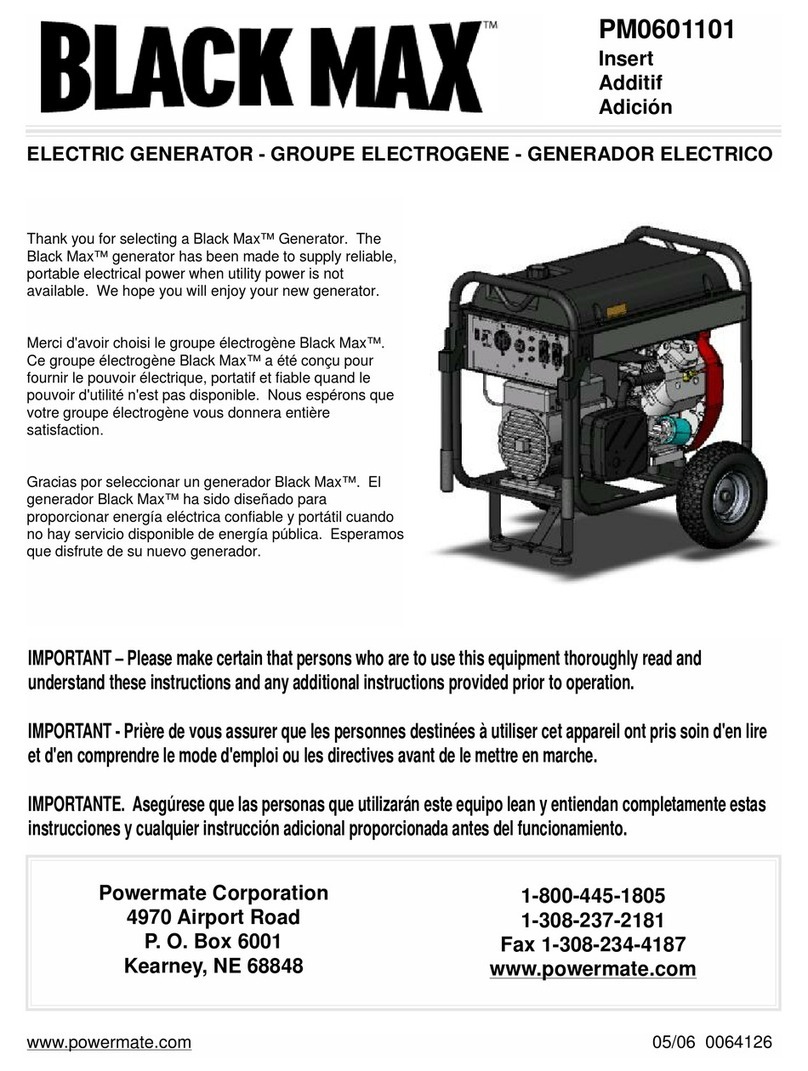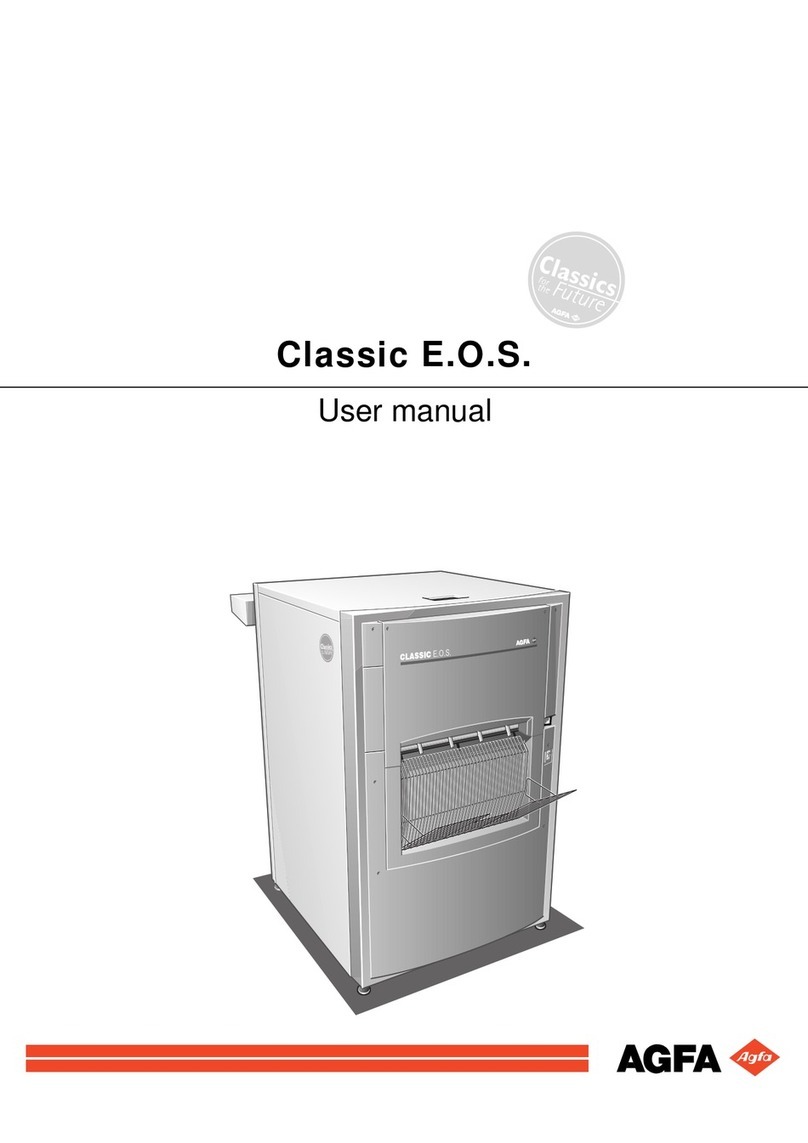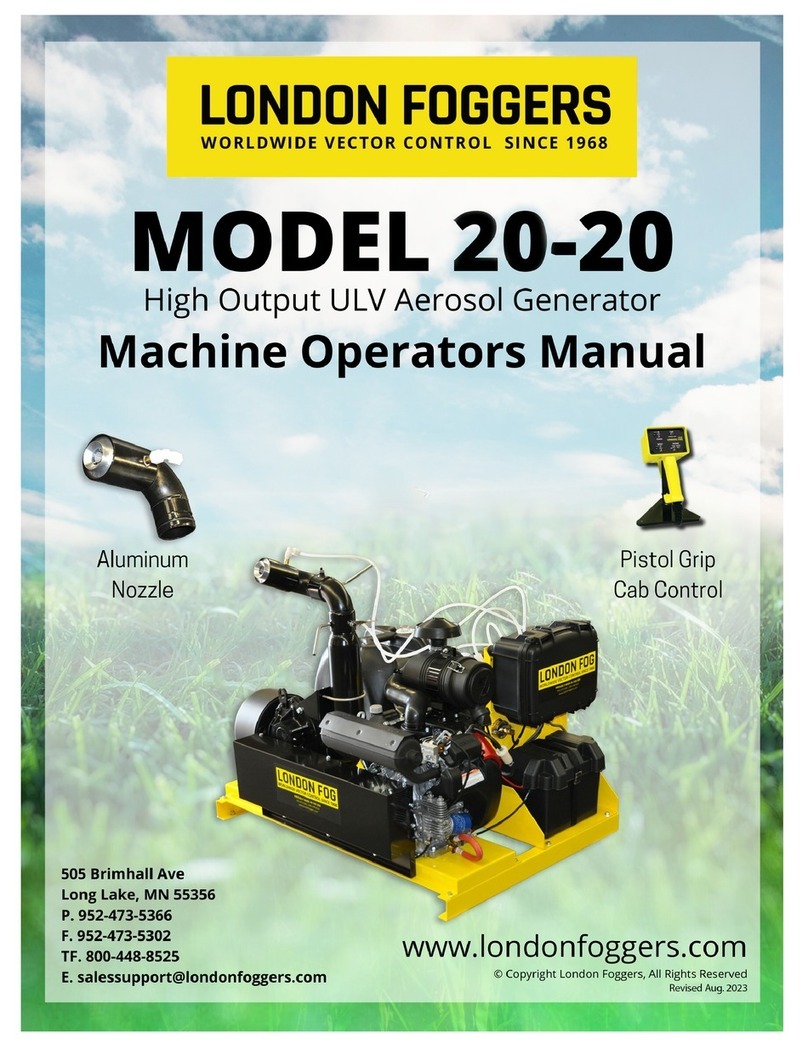Smart Generators Motorhead SG12003 User manual

Smart Generators Operating Instructions SG12003
Please read and save these instructions. Read carefully before attempting to assemble, install, operate or maintain the product described. Protect
yourself and others by observing all safety information. Failure to comply with instructions could result in personal injury and/or property damage!
Retain instructions for future reference.
The Motorhead®Gasoline Generator
Unpacking
When unpacking the unit, carefully
inspect for signs of obvious or
concealed freight damage. If damage
does exist, file a claim with the
transportation company immediately.
Be sure that all damaged parts are
replaced and that the mechanical and
electrical problems are corrected prior
to operation of the unit.
Specifications
Engine…………….…....Honda GX630
Watts (AC) Rated…........12000 watts
Watts (AC) Max………....20000 watts
Rated Voltage (AC)...........120V/240V
Max. Amperage...................166/83 A
Cont. Amperage..................100/50 A
Frequency................................60 Hz
Fuel Tank Capacity................13.2 gal
Run Time (Gasoline)...............8.0 hrs
Weight…………………...420 pounds
Dimensions (in)
31.5" x 24" (30" with wheels) x 37.5"
General Safety Information
READ OPERATING INSTRUCTIONS
Always become familiar with all the
instructions and warnings before
operating any generator
IMPORTANT SAFETY INSTRUCTIONS
To reduce the risk of injury, read
this operator’s manual completely
before using. When using this
product, the following basic
precautions should always be
followed:
1. Read all the instructions before
using the product.
2. Do not allow children or untrained
persons to operate the generator.
3. Do not operate the generator when
fatigued or under the influence of
drugs or chemicals. Stay alert. Watch
what you are doing.
4. Follow the maintenance instructions
specified in this manual.
5. Be sure the switch on electric
power tools is in the “OFF” position
before plugging them into the
generator.
6. Keep the immediate area free of all
bystanders.
7. Be sure each person who operates
this generator is properly instructed in
its safe operation.
8. Do not operate the generator or any
electrical tool in any area where water
or similar materials constitute an
electrical hazard to the operator. Do
not operate on wet surfaces, in rain or
in snow.
9. Always be sure that the generator
is on secure footing so that it cannot
slide or shift around, endangering
workers.
10. Avoid contacting the hot exhaust
manifold, muffler or cylinder(s).
Keep clear of all rotating parts.
11. Unless the tool or appliance
is double insulated, it must be
grounded through a properly
grounded receptacle. (See Preparing
the Generator, Grounding
Instructions). Tools and appliances
which have 3 prong plugs must be
plugged into extension cords and
electrical receptacles with 3 holes.
Before operating any electrical item,
be sure it is in good repair.
12. Beware of using this equipment
in confined spaces. Confined
spaces, without sufficient fresh air
ventilation,can contain dangerous
gases. Running gasoline engines in
such environments can lead to deadly
explosions and/or asphyxiation.
13. Use extreme caution when lifting
this generator. Do not use dolly
handles to lift this generator, use
only designated lifting hook to lift
this generator. This generator is
1

Smart Generators Operating Instructions SG12003
heavy so proper lifting techniques
should be used.
SAVE THESE INSTRUCTIONS
CARBON MONOXIDE-POISONOUS
GAS Use generator outdoors, away
from open windows, vents, or doors.
Generator exhaust contains carbon
monoxide - a poisonous gas that can
kill you. You CAN NOT smell or see
this gas. Never use a generator in
enclosed or partially-enclosed spaces.
Generators can produce high levels of
carbon monoxide very quickly.
When you use a portable generator,
remember that you cannot smell or
see carbon monoxide.
Even if you can’t smell exhaust fumes,
you may still be exposed to carbon
monoxide. If you start to feel sick,
dizzy, or weak while using a
generator, get to fresh air RIGHT
AWAY. DO NOT DELAY. The carbon
monoxide from generators can
rapidly lead to full incapacitation and
death.
If you experience serious symptoms,
get medical attention immediately.
Inform medical staff that carbon
monoxide poisoning is suspected. If
you experienced symptoms while
indoors, have someone call the fire
department to determine when it is
safe to re-enter the building.
Never operate the generator in an
explosive atmosphere, near
combustible materials or where
ventilation is not sufficient to carry
away exhaust fumes.
Exhaust fumes can cause serious
injury or death.
NEVER use a generator indoors,
including in homes, garages,
basements, crawl spaces, and other
enclosed or partially-enclosed areas,
even with ventilation. Opening doors
and windows or using fans will not
prevent carbon monoxide build-up in
the home.
Follow the instructions that come
with your generator. Locate the
unit outdoors and away from doors,
windows, and vents that could allow
the carbon monoxide gas to come
indoors.
ONLY run generator outdoors and
away from air intakes.
NEVER run generator inside homes,
garages, sheds, or other
semi-enclosed spaces. These spaces
can trap poisonous gases EVEN IF
you run a fan or open doors and
windows.
If you start to feel sick, dizzy, or weak
while using the generator, shut if off
and get fresh air RIGHT AWAY. See a
doctor. You may have carbon
monoxide poisoning.
Install battery-operated carbon
monoxide alarms or plug-in carbon
monoxide alarms with battery back-
up in your home, according to the
manufacturer’s installation
instructions.
The carbon monoxide alarms should
be certified to the requirements of
the latest safety standards for carbon
monoxide alarms. (UL 2034, IAS 6-96,
or CSA 6.19.01).
Test your carbon monoxide alarm
frequently and replace dead batteries.
SAFETY WARNING WHEN REFUELING
Gasoline is extremely flammable and
its vapors can explode if ignited.
Observe all safety regulations for the
safe handling of fuel. Handle fuel in
safety containers. If the container
does not have a spout, use a funnel.
Do not overfill the fuel tank, leave
room for the fuel to expand.
Do not refill fuel tank while the
engine is running. Before refueling the
generator, turn it off and let it cool
down. Gasoline spilled on hot engine
parts could ignite. Fill the tank only on
an area of bare ground. While fueling
the tank, keep heat, sparks and open
flame away. Carefully clean up any
spilled fuel before starting engine.
Always fill fuel tank in an area with
plenty of ventilation to avoid inhaling
dangerous fumes.
NEVER store fuel for your generator
in the home. Gasoline, propane,
kerosene, and other flammable liquids
should be stored outside of living
areas in properly-labeled, non-glass
safety containers. Do not store them
near a fuel-burning appliance, such as
a natural gas water heater in a
garage. If the fuel is spilled or the
container is not sealed properly,
invisible vapors from the fuel can
travel along the ground and can be
ignited by the appliance pilot light or
by arcs from electric switches in the
appliance.
GROUNDING INSTRUCTIONS
This product must be grounded. If it
should malfunction or breakdown,
grounding provides a path of least
resistance for electric current to
reduce the risk of electric shock.
Improper connection of the equipment-
grounding conductor can result in a risk
of electrocution. Check with a qualified
electrician or service person if you
are in doubt as to whether the unit is
properly grounded.
The ground terminal on the frame
must always be used to connect the
generator to a suitable ground source.
The ground path should be made with
#8 size wire. Connect the terminal of
the ground wire between two star
washers and nut then tighten the nut
fully. Connect the other end of the
wire securely to a suitable ground
source.
The National Electric Code contains
several practical ways in which to
establish a good ground source.
Examples given below illustrate a few
of the ways in which a good ground
source may be established.
2

Smart Generators Operating Instructions SG12003
A metal underground water pipe
in direct contact with the earth
for at least 10 feet can be used as
a grounding source. If an pipe is
unavailable, an 8 foot length of pipe or
rod may be used as the ground
source.
The pipe should be 3/4 inch trade size
or larger and the outer surface must
be non corrosive. If a steel or iron rod
is used it should be at least 5/8 inch
diameter and if a nonferrous rod is
used it should be at least 1/2 inch
diameter and be listed as material for
grounding. Drive the rod or pipe to a
depth of 8 feet. If a rock bottom is
encountered less than 4 feet down,
bury the rod or pipe in a trench. All
electrical tools and appliances
operated from this generator, must be
properly grounded by use of a third
wire or be
“Double Insulated”.
It is recommended to:
1. Use electrical devices with 3 prong
power cords.
2. Use an extension cord with a 3 hole
receptacle and a 3 prong plug at the
opposite ends to ensure continuity of
the ground protection from the
generator to appliance.
We strongly recommend that all
applicable federal, state and local
regulations relating to grounding
specifications be checked and
followed.
LINE TRANSFER SWITCH
If this generator is used for standby
service, it must have a transfer switch
between the utility power service and
the generator. The transfer switch not
only prevents the utility power form
feeding into the generator, but is also
prevents the generator from feeding
out into the utility company’s lines.
This is intended to protect the
serviceman who may be working on a
damaged line.
THIS INSTALLATION MUST BE DONE BY
A LICENSED ELECTRICIAN AND ALL
LOCAL CODES MUST BE FOLLOWED.
ENGINE OIL
Oil is a major factor affecting
performance and service life. Use 4-
stroke automotive detergent oil.
Recommended Oil: Use 4-stroke
motor oil that meets or exceeds
the requirements for API service
classification SJ, SL, or equivalent.
Always check the API service label on
the oil container to be sure it includes
the letters SJ, SL, or equivalent.
SAE 10W-30 is recommended for
general use. Other viscosities shown
in the chart may be used when the
average temperature in your area is
within the indicated range.
Pre-Operation
FUELING
To fill with oil:
1. Level the engine to ensure accurate
inspection and to prevent overfilling.
2. Remove the dipstick and wipe it
clean.
3. Fully insert the dipstick, then
remove it to check the oil level.
NOTE: When checking the oil be sure the
engine is level.
4. If the oil level is low, remove the
oil filler cap, and fill to the upper
limit mark on the dipstick with the
recommended oil.
5. Reinstall the dipstick and filler cap.
NOTE: Running the engine with a low
oil level can cause engine damage.
The Oil Alert system (applicable
types) will automatically stop the
engine before the oil level falls below
the safe limit. However, to avoid the
inconvenience of an unexpected
shutdown, always check the engine oil
level before startup.
WARNING! EXPLOSIVE FUEL! GASOLINE
IS EXTREMELY FLAMMABLE AND ITS
VAPORS CAN EXPLODE IF IGNITED.
STORE GASOLINE ONLY IN APPROVED
CONTAINERS, IN WELL VENTILATED,
UNOCCUPIED BUILDINGS AND AWAY
FROM SPARKS OR FLAMES.
DO NOT FILL THE FUEL TANK WHILE
THE ENGINE IS HOT OR RUNNING,
SINCE
SPILLED FUEL COULD IGNITE IF IT
COMES IN CONTACT WITH HOT PARTS
OR SPARKS FROM IGNITION. DO NOT
START THE ENGINE NEAR SPILLED
FUEL.
NEVER USE GASOLINE AS A CLEANING
AGENT.
DO NOT OVERFILL THE FUEL TANK,
LEAVE ROOM FOR THE FUEL TO
EXPAND.
GENERAL RECOMMENDATIONS
• Purchase gasoline in small
quantities and store in clean,
approved containers.
• To minimize gum deposits in your
fuel system and to insure easy
starting, do not use gasoline left
over from the previous season.
• Do not add oil to the gasoline.
FUEL TYPE
• For best results use only clean,
fresh, unleaded gasoline with a
pump sticker octane rating of 87 or
higher.
• Unleaded gasoline is
recommended as it leaves less
combustion chamber deposits.
Gasoline/Alcohol Blends:
Gasohol (up to 10% ethyl alcohol,
90% unleaded gasoline by volume)
is approved, as a fuel. Other
gasoline/ alcohol blends are not
approved.
Gasoline/Ether Blends:
Methyl Tertiary Butyl Ether (MTBE)
and unleaded gasoline blends (up
to a maximum of 15% MTBE by
volume) are approved as a fuel.
Other gasoline/ether blends are not
approved.
3

Smart Generators Operating Instructions SG12003
HIGH ALTITUDE
At high altitude, the standard
carburetor air/fuel mixture will be
too rich.
Performance will decrease, and fuel
consumption will increase. A very
rich mixture will also foul the spark
plug and cause hard starting.
Operation at an altitude that differs
from that at which this engine was
certified, for extended periods of
time, may increase emissions.
High altitude performance can be
improved by specific modifications
to the carburetor. If you always
operate your generator at altitudes
above 5,000 feet (1,500 meters),
have your dealer perform this
carburetor modification. This
engine, when operated at high
altitude with the carburetor
modifications for high altitude use,
will meet each emission standard
throughout its useful life. Even with
carburetor modification, engine
horsepower will decrease about
3.5% for each 1,000-foot
(300-meter) increase in altitude.
The effect of altitude on
horsepower will be greater than
this if no carburetor modification is
made.
NOTE:When the carburetor has been
modified for high altitude operation,
the air/fuel mixture will be too lean for
low altitude use. Operation at altitudes
below 5,000 feet (1,500 meters) with
a modified carburetor may cause the
engine to overheat and result in serious
engine damage. For use at low altitudes,
have your servicing dealer return the
carburetor to original factory
specifications.
Operation (Gasoline)
ELECTRIC START
NOTE: Read Operator’s Manual carefully
before operating this unit. Always
make sure the unit is level and properly
grounded. Check engine oil before
starting.
1. Open the valve leading from the
gasoline tank to the carburetor.
2. Move choke lever to full choke. If
re-starting a warm engine, the choke
should be left in the off position. (See
Above)
3. Turn the key to the START position,
hold until engine starts.
4. When the engine starts, release
key, allowing it to return to the ON
position.
NOTE: Do not crank the engine
continuously for more than 30 seconds
at a time. If the engine does not start,
allow for a 3 minute cool down period
between starting attempts. Failure to
follow these guidelines can damage the
starter motor.
If the starter does not turn the engine
over, shut off the starter immediately.
Do not make further attempts to
start the engine until the condition
is corrected. Do not jump start using
another battery.
5. Slowly move choke lever to no
choke.
6. Allow unit to run two (2) minutes to
warm-up.
NOTE: This engine is equipped with a
“Low Oil” shutdown system for engine
protection. The engine stops when the
oil level gets too low. The engine will
not restart without adding oil. Refer to
Preparing the Generator; Engine Fuel
Capacity for instructions on adding oil.
NOTE: While the engine is idling, the
generator voltage is automatically
reduced to reduce generator
temperatures. The voltage will return
to normal levels immediately upon the
application of load.
SHUTDOWN
1. Remove all load by turning off
electrical appliances and unplugging
electric cords.
2. Allow engine to run at idle speed to
cool for two (2) minutes.
NOTE: Failure to allow the engine to cool
at idle for two (2) minutes may result in
damage to the generator.
3. Turn engine key or ignition switch
off.
Maintenance
GENERATOR MAINTENANCE
Keep all air vents clear.
Keep the generator clean. DO NOT
spray with water.
Periodically check all fasteners and
tighten, see the periodic maintenance
chart.
EVAPORATIVE EMISSION
COMPONENTS:
The unit you have purchased includes
the following components that are in
compliance with 2008 California Air
Resources Board Evaporative
Emission
Standards;
1. Fuel Hose
2. Fuel Hose Fittings
These components should be
inspected on a daily basis for cracks,
leaks, and abnormal wear. If cracking,
leaks or abnormal wear has occurred,
the components should be replaced
immediately.
ENGINE:
The engine for this generator is
governed to operate at speeds close
to 3600 RPM (60Hz) throughout the
operating load range. The no load
speed (before a load is applied) will
be just a bit higher than the load
speed and is normally set to 3750
RPM.
DO NOT TAMPER WITH THE GOVERNOR
MECHANISM, CHANGE THE SETTING
EXPERIMENTALLY, OR PUSH THE
4

Smart Generators Operating Instructions SG12003
THROTTLE OPEN IN AN ATTEMPT TO
GENERATE MORE ELECTRICAL
CURRENT; EQUIPMENT DAMAGE OR
PERSONAL INJURY MAY RESULT.
CHECKING ENGINE OIL:
Check oil level before each operation
and ensure that it is maintained per
Preparing the Generator; Engine Oil
Capacity section.
CHANGING ENGINE OIL:
Change oil after the first 20 hours of
operation. Thereafter it should be
changed every 100 hours.
1. Make sure the unit is on level
ground.
Drain the used oil when the engine
is warm. Warm oil drains quickly and
completely.
2. Stop the engine.
3. Place a suitable container below
the engine to catch the used oil, then
remove the filler cap, drain bolt and
washer.
Oil being drained may be hot. To reduce
the risk of burn injury, handle with care.
Dispose of used oil properly.
4. Allow the used oil to drain
completely, then reinstall the drain bolt
and washer, and tighten the drain bolt
securely.
Dispose of used motor oil in a manner
that is compatible with the
environment. We suggest you take
used oil in a sealed container to
your local recycling center or service
station for reclamation. Do not throw it
in the trash, pour it on the ground, or
down a drain.
5. With the engine in a level position,
fill to the upper limit mark on the
dipstick with the recommended oil.
NOTE: Running the engine with a low oil
level can cause engine damage.
The Oil Alert system (applicable types)
will automatically stop the engine before
the oil level falls below the safe limit.
However, to avoid the inconvenience of
an unexpected shutdown, fill to the upper
limit, and check the oil level regularly.
6. Remove filler cap and refill with
new oil.
7. Reinstall the filler cap and dipstick
securely.
AIR CLEANER:
RISK OF FIRE OR EXPLOSION. DO NOT
USE GASOLINE OR LOW FLASH-POINT
SOLVENTS TO CLEAN THE ELEMENT.
CLEAN THE ELEMENT IN A WELL
VENTILATED AREA. ENSURE THAT NO
SPARKS OR FLAMES ARE NEAR THE
WORKING AREA, THIS INCLUDES ANY
APPLIANCE WITH A PILOT LIGHT. NEVER
RUN THE ENGINE WITHOUT THE AIR
FILTER, SERIOUS DANGER CAN RESULT.
Check the air cleaner daily or before
starting the engine. Check for and
correct heavy buildup of dirt and
debris along with loose or damaged
components.
1. Release the four latch tabs or
remove the wing nut from the air
cleaner cover, and remove the cover.
2. Remove the foam filter from the
cover.
3. Remove the paper filter from the air
cleaner case. (if applicable)
4. Inspect air filter elements, and
replace if damaged.
5. Clean the air filter elements if they
are to be reused.
FOAM FILTER ELEMENT:
Wash the foam filter element in warm
water with detergent. Rinse the foam
filter element thoroughly until all
traces of detergent are eliminated.
Squeeze out excess water, but do not
wring. Allow the foam filter element to
air dry. Saturate the foam filter
element with new engine oil. Squeeze
out all excess oil. DO NOT put engine
oil on the foam damper.
NOTE: Clean the foam filter element every
25 hours of operation (more often under
extremely dusty or dirty condition)
PAPER AIR CLEANER ELEMENT:
Do not wash the paper element or use
pressurized air, as this will damage
the element. Clean by gently tapping
the element to remove dust. Replace
the element if damaged, bent or
extremely dirty. Handle new element
carefully; do not use if the sealing
surfaces are bent or damaged.
NOTE: Replace the paper element
every 100 hours (more often under
extremely dusty conditions.)
6. Wipe dirt from the inside of the air
cleaner body and cover, using a
moist rag. Be careful to prevent dirt
From entering the air chamber that
leads to the carburetor.
7. Place the foam air filter element
in the air cleaner cover. If
applicable, reinstall the paper air
filter element and cover to the air
cleaner case. Replace cover
securely.
5

Smart Generators Operating Instructions SG12003
CLEANING AND GAPPING
SPARK PLUG:
If the plug is contaminated with
carbon, remove it using a plug
cleaner or wire brush. Check the
spark plug gap and reset it if
necessary. The spark plug gaps
are listed below. To change the
gap, bend the side-electrode only,
using a spark plug tool. Install and
tighten the spark plug. Connect the
spark plug lead.
If the generator has been running,
the muffler will be very hot. Allow it
to cool before proceeding.
NOTE: Remove and clean spark
arrester every 100 hours or as
necessary.
NOTE: Product users on United States
forest service land, and in some
states, must comply with fire
prevention regulations.
Clean the spark arrester as
follows:
1. Remove the screw from the
muffler and remove the spark
arrester.
2. Use a brush to remove carbon
deposits from the spark arrester
screen.Be careful to avoid
damaging the screen. The spark
arrester must be free of breaks
and holes. Replace the spark
arrester if it is damaged.
3.Install the spark arrester and
muffler protector in the reverse
order of disassembly. Spark
arrestors are available
from your Smart Generators
Customer Service Representative.
Other user requirements may
apply, check with your Federal,
State or local authorities.
Storing Generator
SHORT TERM (1-6 MONTHS):
1. Add gasoline conditioner and
stabilizer at the specified
concentration.
2. Run the unit for two (2) minutes
to ensure the mixed fuel is in the
entire fuel system. Close the fuel
valve and run the unit until it stops.
3. Remove the spark plug, pour
1-2 teaspoons (5-10cc) of engine
oil into the cylinder, slowly pull the
starter handle 2 or 3 times,
reinstall the spark plug and tighten
securely.
4. Clean the exterior surface of the
generator and apply a rust
inhibitor.
5. Store the generator in a dry, well
ventilated place.
LONG TERM (MORE THAN 6
MONTHS):
1. Add gasoline conditioner and
stabilizer at the specified
concentration.
2. Run the generator until the fuel
tank and carburetor are dry. As the
engine is beginning to die, move
the choke lever to the choke
position.
3. Remove the spark plug, pour
1-2 teaspoons (5-10cc) of engine
oil into the cylinder, slowly pull the
starter handle 2 or 3 times,
reinstall the spark plug and tighten
securely.
4. Clean the exterior surface of the
generator and apply a rust
inhibitor.
5. Store the generator in a dry, well
ventilated place.
FUEL SHOULD BE DRAINED IN A
WELL VENTILATED AREA AND
STORED IN A CONTAINER
APPROVED FOR GASOLINE.
6

Smart Generators Operating Instructions SG12003
7

Smart Generators Operating Instructions SG12003
8

Smart Generators Operating Instructions SG12003
LIMITED WARRANTY
SMART GENERATORS THREE-YEAR LIMITED WARRANTY. SMART GENERATORS Generator, MODELS
COVERED IN THIS MANUAL, ARE WARRANTED BY SMART GENERATORS LLC. TO THE ORIGINAL USER
AGAINST DEFECTS IN WORKMANSHIP OR MATERIALS UNDER NORMAL USE FOR THREE YEAR AFTER DATE
OF PURCHASE. ANY PART WHICH IS DETERMINED TO BE DEFECTIVE IN MATERIAL OR WORKMANSHIP AND
RETURNED TO AN AUTHORIZED SERVICE LOCATION, AS SMART GENERATORS DESIGNATES, SHIPPING
COSTS PREPAID, WILL BE, AS THE EXCLUSIVE REMEDY, REPAIRED OR REPLACED AT SMART GENERATORS
OPTION. FOR LIMITED WARRANTY CLAIM PROCEDURES, SEE “PROMPT DISPOSITION” BELOW. THIS LIMITED
WARRANTY GIVES PURCHASERS SPECIFIC LEGAL RIGHTS WHICH VARY FROM JURISDICTION TO
JURISDICTION.
LIMITATION OF LIABILITY. TO THE EXTENT ALLOWABLE UNDER APPLICABLE LAW, SMART GENERATORS
LIABILITY FOR CONSEQUENTIAL AND INCIDENTAL DAMAGES IS EXPRESSLY DISCLAIMED. SMART
GENERATORS LIABILITY IN ALL EVENTS IS LIMITED TO AND SHALL NOT EXCEED THE PURCHASE PRICE PAID.
WARRANTY DISCLAIMER. A DILIGENT EFFORT HAS BEEN MADE TO PROVIDE PRODUCT INFORMATION AND
ILLUSTRATE THE PRODUCTS IN THIS LITERATURE ACCURATELY; HOWEVER, SUCH INFORMATION AND
ILLUSTRATIONS ARE FOR THE SOLE PURPOSE OF IDENTIFICATION, AND DO NOT EXPRESS OR IMPLY A
WARRANTY THAT THE PRODUCTS ARE MERCHANTABLE, OR FIT FOR A PARTICULAR PURPOSE, OR THAT THE
PRODUCTS WILL NECESSARILY CONFORM TO THE ILLUSTRATIONS OR DESCRIPTIONS. EXCEPT AS
PROVIDED BELOW, NO WARRANTY OR AFFIRMATION OF FACT, EXPRESSED OR IMPLIED, OTHER THAN AS
STATED IN THE “LIMITED WARRANTY” ABOVE IS MADE OR AUTHORIZED BY SMART GENERATORS.
Technical Advice and Recommendations, Disclaimer. Notwithstanding any past practice or dealings or trade custom,
sales shall not include the furnishing of technical advice or assistance or system design. SMART GENERATORS
assumes no obligations or liability on account of any unauthorized recommendations, opinions or advice as to the choice,
installation or use of products.
Product Suitability. Many jurisdictions have codes and regulations governing sales, construction, installation, and/or use
of products for certain purposes, which may vary from those in neighboring areas. While attempts are made to assure that
SMART GENERATORS products comply with such codes, SMART GENERATORS cannot guarantee compliance, and
cannot be responsible for how the product is installed or used. Before purchase and use of a product, review the product
applications, and all applicable national and local codes and regulations, and be sure that the product, installation, and
use will comply with them. Certain aspects of disclaimers are not applicable to consumer products; e.g., (a) some
jurisdictions do not allow the exclusion or limitation of incidental or consequential damages, so the above limitation or
exclusion may not apply to you; (b) also, some jurisdictions do not allow a limitation on how long an implied warranty lasts,
consequently the above limitation may not apply to you; and (c) by law, during the period of this Limited Warranty, any
implied warranties of implied merchantability or fitness for a particular purpose applicable to consumer products
purchased by consumers, may not be excluded or otherwise disclaimed.
Prompt Disposition. A good faith effort will be made for prompt correction or other adjustment with respect to any
product which proves to be defective within limited warranty. For any product believed to be defective within limited
warranty, first write or call dealer from whom the product was purchased. Dealer will give additional directions. If unable to
resolve satisfactorily, write to Smart Generators at address below, giving dealer’s name, address, date, and number of
dealer’s invoice, and describing the nature of the defect. Title and risk of loss pass to buyer on delivery to common carrier.
If product was damaged in transit to you, file claim with carrier.
Manufactured by Smart Generators, LLC, 1010 Central Ave, Woodmere NY 11598 U.S.A.
Toll Free: 844-TRI-FUEL Local: 516-224-3363
9
Table of contents
Other Smart Generators Portable Generator manuals
Popular Portable Generator manuals by other brands

Anritsu
Anritsu MG369XA Series Programming manual
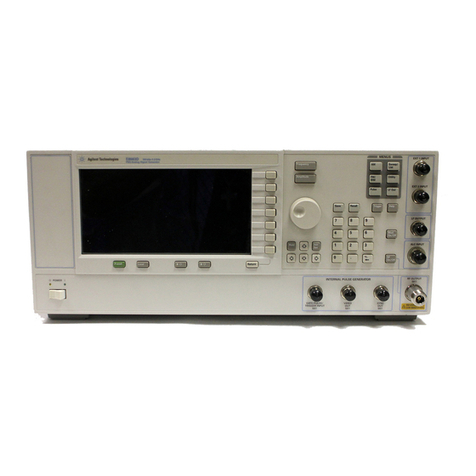
Keysight Technologies
Keysight Technologies E8257D Service guide
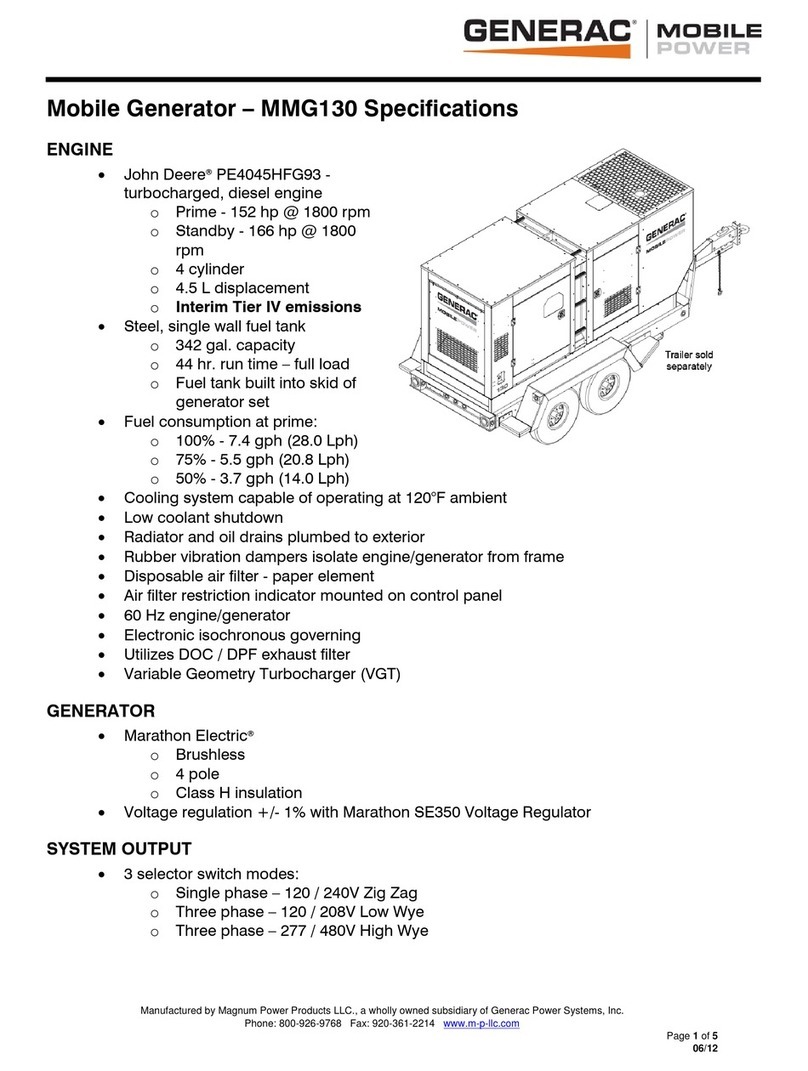
Generac Power Systems
Generac Power Systems Mobile Power MMG130 Specifications
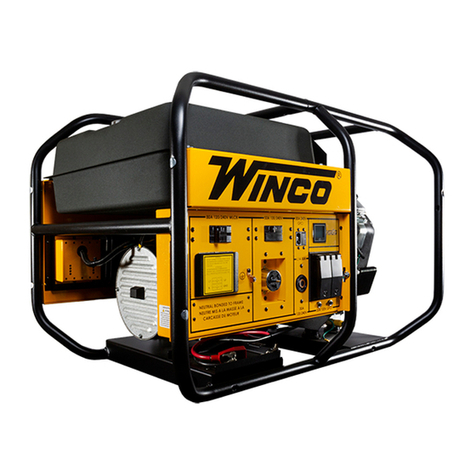
Winco
Winco WL22000VE Installation & operator's manual
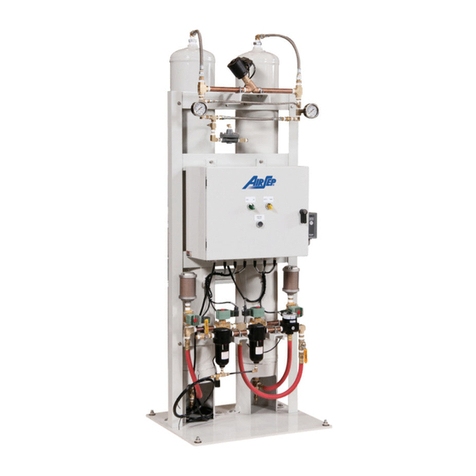
AirSep
AirSep ALPHA Series instruction manual
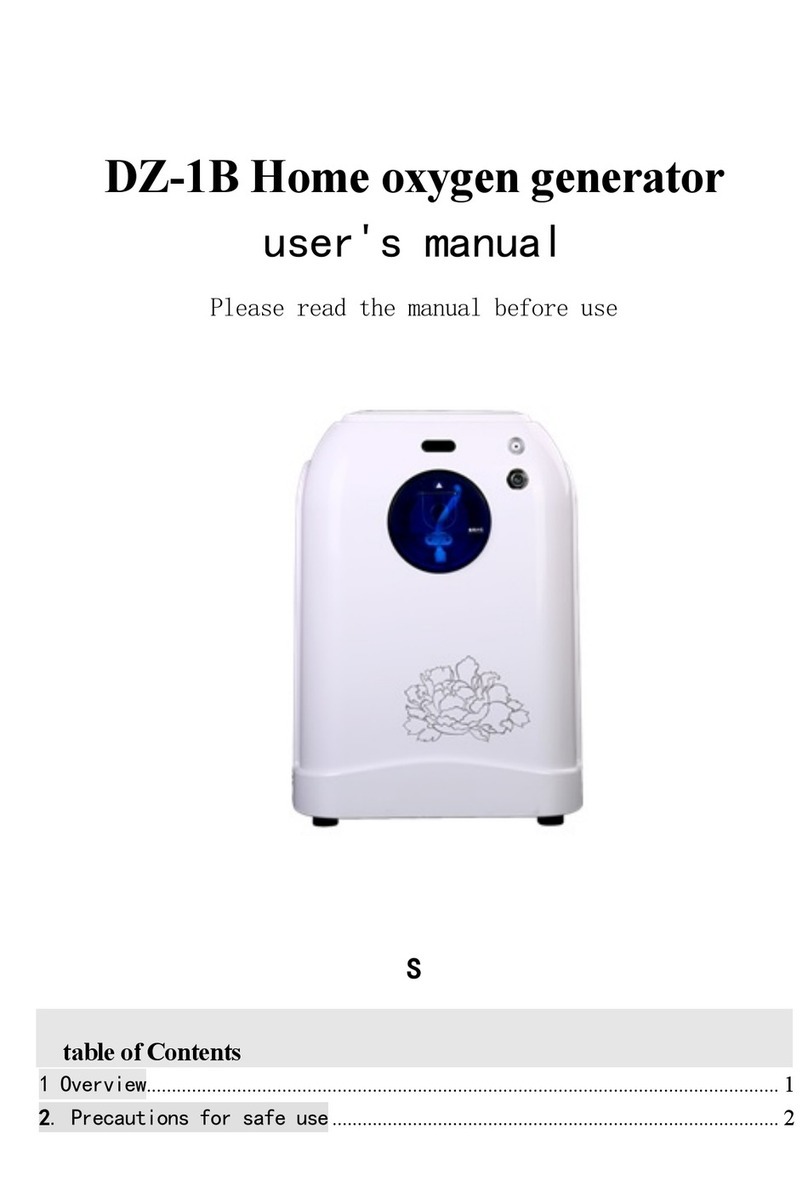
Juren
Juren DZ-1B user manual
